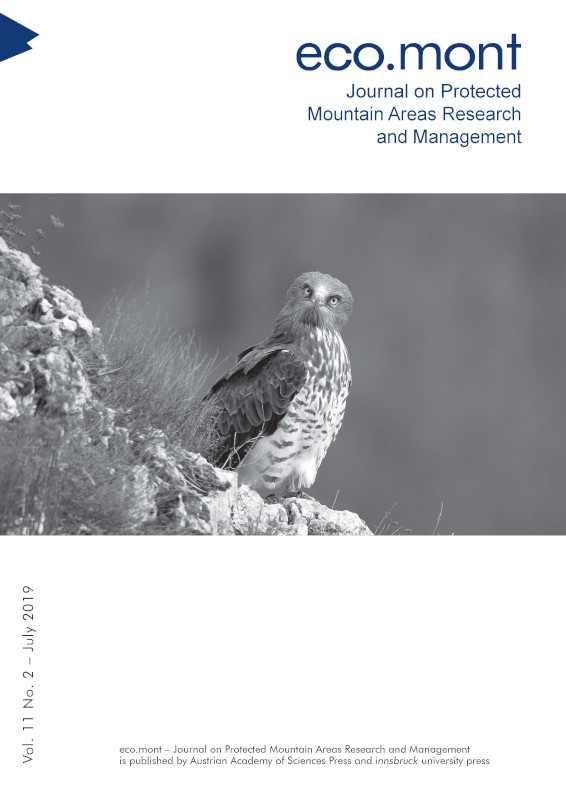Valerie Braun – Martin Coy – Günter Köck (Eds.)
eco.mont
Journal on Protected Mountain Areas Research and Management
Abraham Paulsen,
Danilo Petrovich,
Andrés Moreira-Muñoz
S. 50 - 54
doi:
10.1553/eco.mont-11-2s50
Verlag der Österreichischen Akademie der Wissenschaften
doi:
10.1553/eco.mont-11-2s50
Abstract:
The potential benefits of integrating vernacular religious beliefs into biodiversity conservation and sustainability actions have been emphasized widely, while specific examples and the synergies between religious communities and conservationists in particular spaces deserve more attention. The manifestations of vernacular religions in territories devoted to sustainability, such as Biosphere Reserves (BRs), are a particularly rich area for study. While La Campana-Peñuelas BR has long been recognized as a territory where local religion is an important feature, greater awareness of this and of the potential link to sustainability actions is still lacking, as is awareness of the potential of the BR to become a Multi-Internationally Designated Area. Here we report on the diversity of popular religious activities within the BR. Possible synergies between popular religion and sustainability are based on the strong organizational capacities of local communities, and on an ethical vision of social justice that encompasses both human relations and attitudes towards the non-human beings within the biosphere.
vernacular religion, Multi-Internationally Designated Areas, natural sanctuaries, Chile
Published Online:
2019/07/01 12:40:04
Document Date:
2019/07/01 12:19:00
Object Identifier:
0xc1aa5576 0x003abf0e
Rights:https://creativecommons.org/licenses/by-nc-nd/4.0/
The journal “eco.mont” – Journal of protected mountain areas research and management – was published for the first time in June 2009.
The journal was founded as a joint initiative of the Alpine Network of Protected Areas (ALPARC), the International Scientific Committee on Research in the Alps (ISCAR), the Austrian Academy of Sciences (ÖAW) and the University of Innsbruck.
The journal aims to highlight research on and management issues in protected areas in the Alps without excluding other protected mountain areas in Europe or overseas. Its target audiences are scientists from all related disciplines, managers of protected areas and interested individuals including practitioners, visitors, teachers, etc.
The journal presents peer-reviewed articles in English by authors who research protected mountain areas and management issues within these areas. It's published twice a year as a collaboration of the Austrian Academy of Sciences Press – responsible for the e-version – and Innsbruck University Press – responsible for the print version.
Die Zeitschrift „eco.mont“ – Zeitschrift zur Forschung in Gebirgsschutzgebieten – erschien im Juni 2009 zum ersten Mal. Die Zeitschrift wurde auf Initiative des Netzwerks Alpiner Schutzgebiete (ALPARC), der Schweizer Akademie der Naturwissenschaften (ISCAR), der Österreichischen Akademie der Wissenschaften (ÖAW) und der Universität Innsbruck gegründet. Sie hat das Ziel, Themen zu behandeln, die gleichzeitig Forschung und Verwaltung in und über die Schutzgebiete der Alpen betreffen, ohne dabei andere Gebirgsschutzgebiete Europas oder anderswo auszuschließen. Diese neue Zeitschrift richtet sich an ein Publikum von Wissenschaftlern der verschiedensten Fachbereiche, an die Verwalter von Schutzgebieten und an alle sonstigen Interessierten, Praktiker, Besucher, Lehrpersonal etc. einbegriffen. Die Zeitschrift veröffentlicht begutachtete Beiträge auf Englisch von Autoren, die Fragen der Gebirgsschutzgebiete und deren Verwaltung betreffen. Sie erscheint zweimal pro Jahr, auf der Basis der gemeinsamen Anstrengungen des Verlags der Österreichischen Akademie der Wissenschaften, der für die digitale Fassung verantwortlich ist, und der Presse der Universität Innsbruck, verantwortlich für die gedruckte Fassung.



 Home
Home Print
Print
 References
References
 Share
Share

